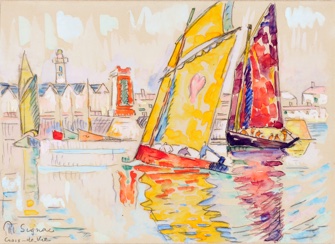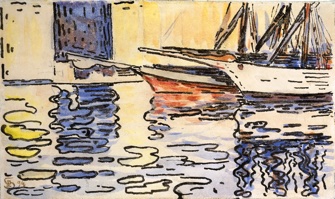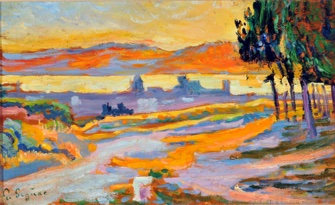
The astonishingly beautiful paintings and drawings by Paul Signac (1863-1935) are less well-known than those of many of his contemporaries because they have been avidly sought by private collectors, who rarely let them go for public exhibitions. A magnificent show of the Frenchman’s work, “Signac: Une Vie au Fil de l’Eau,” at the Fondation de l’Hermitage in Lausanne is well worth the journey to Switzerland to admire this visual gold mine of material sourced so diligently from secretive private collectors.
The most breathtaking element in the exhibition is the wonderful series “Ports de France,” with some 40 views painted on location between 1929 and ’31, commissioned by the wealthy collector Gaston Lévy. These extraordinary drawings and watercolors are all the more remarkable because the artist captured views of the harbors just a few years before they would be drastically altered by war damage some 15 years later. What a spectacular decor they must provide in the living room of the anonymous owner!
Signac’s technique brings audacious verve to paintings based on a lifetime spent studying graphic effects such as color contrasts and Asian calligraphy. A grainy photo dated 1931 shows the artist at work standing on the quayside drawing from life, his paper supported on a large handheld board with a selection of brushes attached to it with an elastic band.
Signac overturned traditional watercolor technique, first making a light pencil sketch, then applying dashes of brilliant, contrasting color, not hesitating to leave blank spaces on the page. Only after the color patches had dried

back in his hotel room would he add contours in black India ink, not rendering an “accurate” drawing but throwing looping contours around the subject. The admirable effect is reminiscent of Japanese calligraphy.
Along with his contemporaries, Signac progressed artistically through Pointillism, inspired by Georges Seurat, to Fauvist experimentation with deliberately unrealistic

colors of screaming intensity. As it had for other painters of this period – Paul Cézanne, Vincent Van Gogh, Paul Gauguin, Georges Braque, André Derain et al – the discovery of the light-saturated beauty of the Provençal coast, particularly in Saint Tropez, proved a life-changing experience.
Like a fascinating book, the Signac show introduces visitors to other artists inspired by similar themes whose accomplished work is also represented here. Among them is Signac’s friend and neighbor Henri-Emmanuel Cross (1856-1910), whose work calls out for further exploration.
Signac’s lifelong fascination with water and sailing boats is reflected in the exhibition. We learn that the artist, who was a skilled yachtsman, owned 33 sailing boats during his life. Returning to the port view mentioned earlier, the pictures show craft of different shapes and sizes, revealing an evident knowledge of masts, sails and rigging, although he took some artistic liberties with his pictures of tall sailing ships: three-masted barques and schooners are shown with all sails hoisted while at berth on the quayside, an unlikely scenario.
The works also include more modern subjects, such as several gray warships, which were later to end up on the bottom of the sea during World War II.
Numerous views of the Seine and other waterways around Paris complete this wonderful and original exhibition, which sheds so much light on the artist. His technique, an inspired effort to find a visual language that is meaningful and memorable, reminds us that landscapes are not just decorative.
Note: After it closes in Lausanne, the exhibition will be presented at the Museo d’Arte della Svizzera Italiana in Lugano September 3, 2016-January 8, 2017.
: . Tel.: . Through .
Favorite
